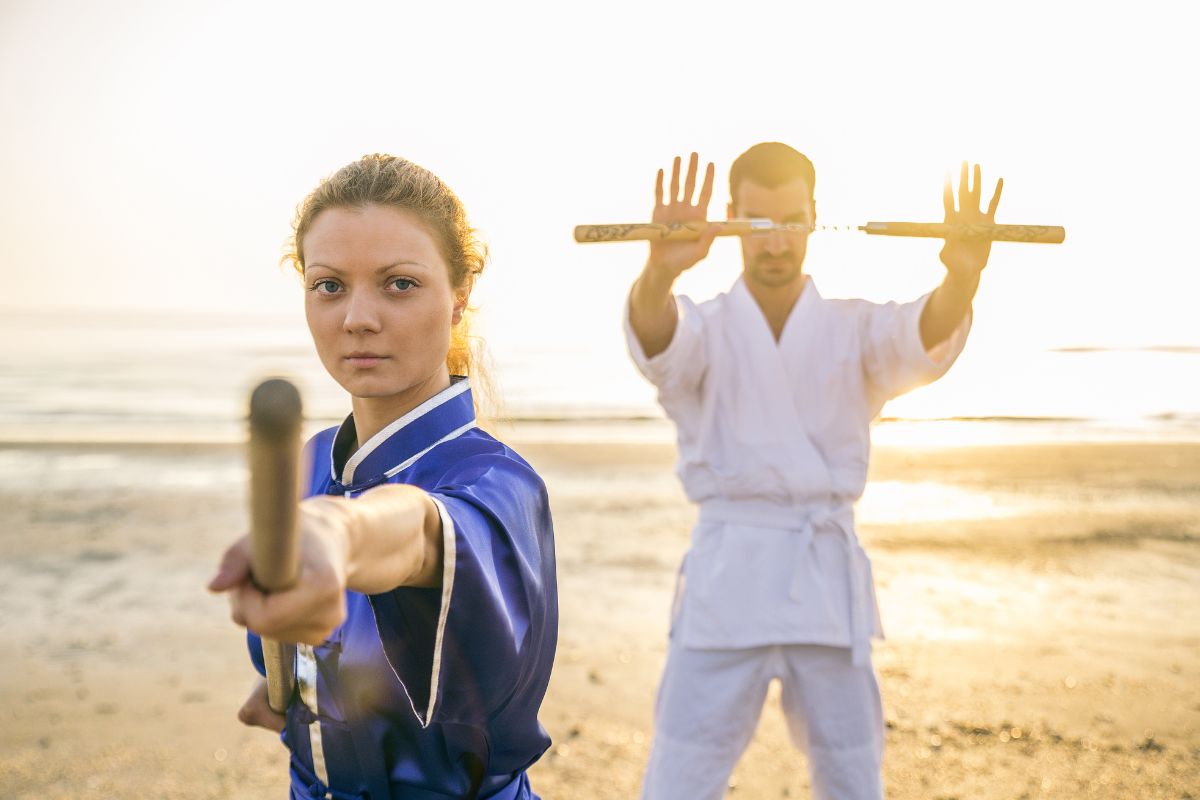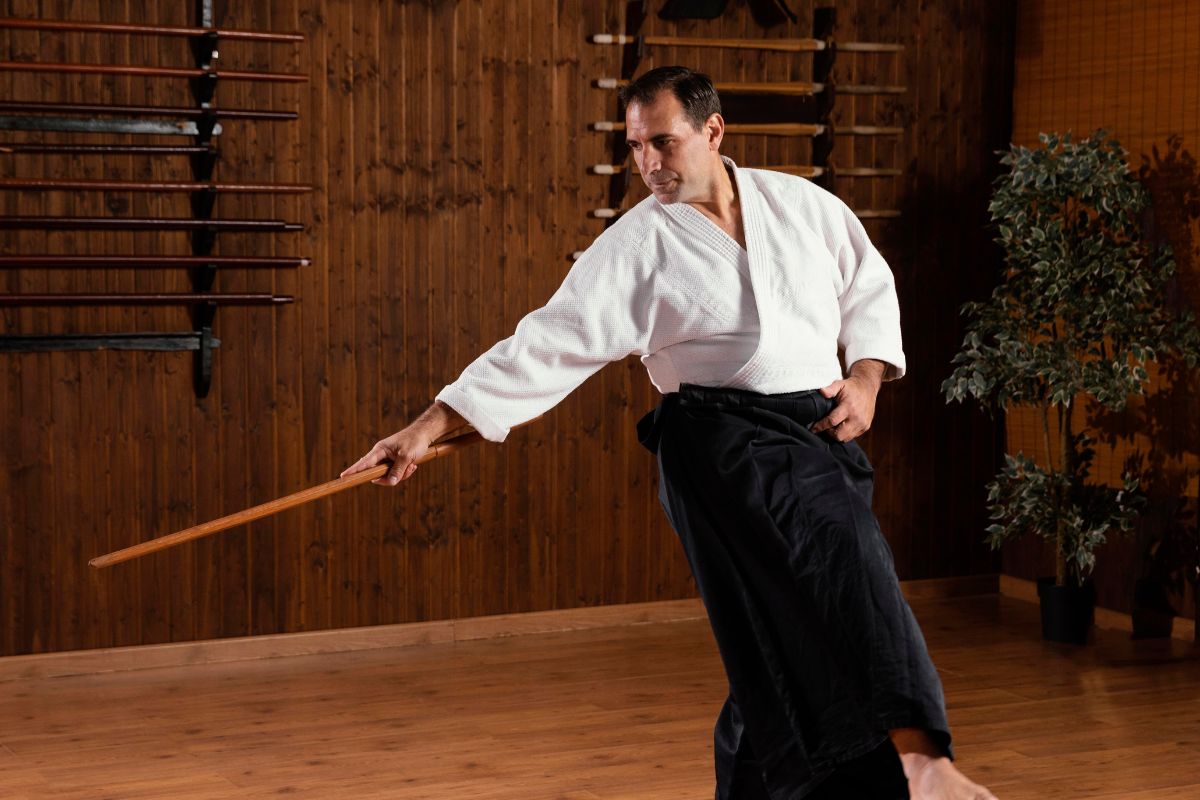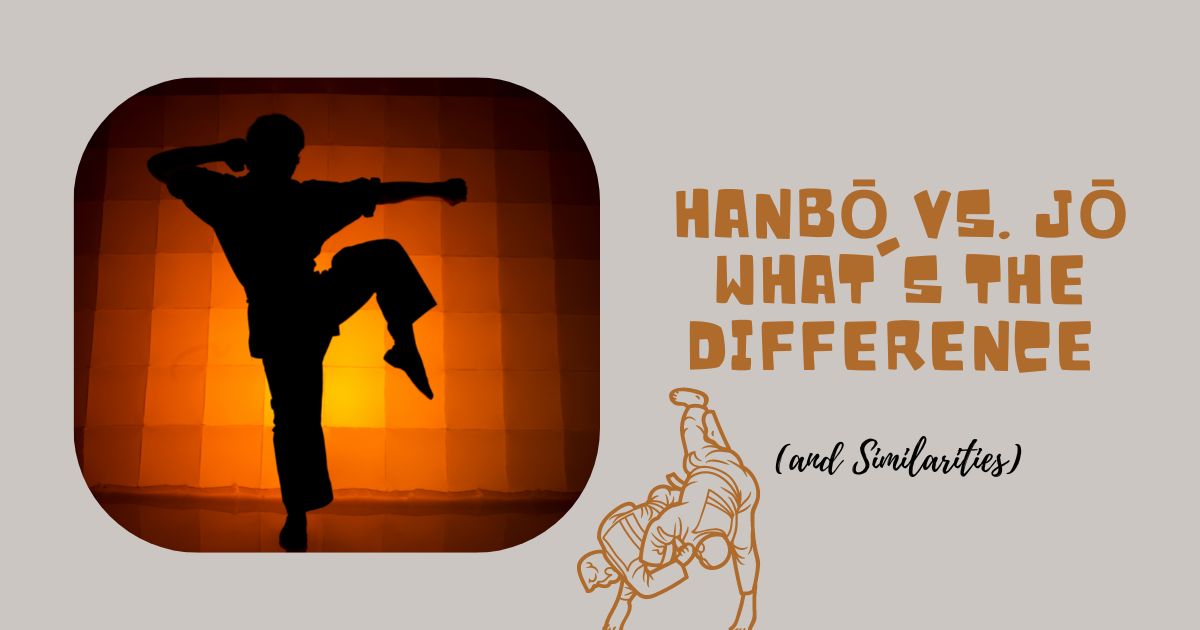What are They?
Hanbō vs. jō (the differences and similarities) is an interesting topic for those who want to know more about traditional Japanese martial arts.
Hanbō and jō both have a long history in Japanese martial arts for centuries used in developing fighting skills and techniques.
Hanbō and jō are both kobudō, which are staff used for weapons training.

What is a Hanbō?
Hanbō is a Japanese term that translates to “half stick.” It is a wooden stick approximately 3 feet (0.91 meters) in length, and it is a training weapon in various martial arts styles, such as aikido, judo, and jiu-jitsu.
The hanbō is the first weapon recommended for new martial artists. The fighter has to hold the stick in the middle with one hand, and use it to strike, block, and defend against attacks.
The Japanese are known for developing the art of hanbōjutsu, translated as half-staff-way, which involves using a short staff in combat to a highly sophisticated level.
This art form demonstrates the versatility and effectiveness of using a short stick in combat and other practical applications.
An origin story recorded for the half-staff technique is in a Japanese battle journal from the 14th century. The story tells of a defending warrior armed with a spear cut in half by an opposing soldier wielding a large tachi sword.
The warrior had only a three-foot section of the staff and used it to fight off their attacker. The warrior adopted a wide-open stance, similar to Hira no kamae, and held the stick in one hand.
When the opposing soldier swung their tachi sword at the warrior, the warrior used quick body evasion skills to avoid the attack and used the stick to knock the soldier’s helmet off. The warrior struck the soldier on the head with a sudden return stroke, cracking their skull.
The hanbō is also a key component of several martial arts styles, including Kukishin-ryū and Kukishinden-ryū, which are part of the Bujinkan Budō Taijutsu system.
The belief is that the Kukishinden-ryū originated in the 14th century, and historical records show that it has roots dating back to the 8th century.
According to these records, a warrior used a wooden weapon of similar length to a sword to defeat a jealous prince who had switched the warrior’s real sword with a wooden stick of the same size.
The wooden stick broke the prince’s steel sword in half during the ensuing fight. Over time, the formal practices and techniques of Kukishinden Ryu, including postures, bowing, and kata, which translates to forms, and waza, which translates to methods, were developed and passed down through the generations.
The current leader of the school is Sensei Masaaki Hatsumi, who founded the Bujinkan Ninjutsu organization.
The hanbō is often used in these styles because it is about the same length as a walking cane. In comparison, techniques with a cane with one rounded end are popular in martial arts styles that may involve pulling or hooking. Otherwise, using a cane in martial arts is the same as using a hanbō.
The Japanese martial arts schools have worked to systematize the techniques used with the hanbō, such as parrying, swinging, smashing, stabbing, grappling, and leveraging. These techniques were then organized and codified into a structured system.
There are several benefits to using a cane as a martial arts weapon which includes the utilization of the tip for poking and thrusting techniques.
The use of a long shaft of the cane is for striking, blocking, and joint locks. Additionally, the hook on the cane can be used for tripping, trapping, or choking an attacker, providing a unique advantage in a fight.
The hanbō can be held by one end and swung like a sword, or it can be held in the middle and used to strike or block from either end.
Knowing how to use a hanbō is useful in cases where one suddenly needs to defend themselves, as hanbō resembles sticks that are in abundance around us and can easily be picked up and used in self-defense situations.
In addition, sticks are a great advantage to the elderly or those who use walking sticks as a defense mechanism.
When used correctly, a hanbō can be an effective tool against a katana. A katana is a Japanese sword with a long, curved blade that is single-edged and has a circular or squared guard. The grip is long enough for one to hold with both hands.
Hanbō vs. Tanbō
Hanbō and tanbō are short sticks or staffs used in martial arts training and sparring. They are similar in length and typically made of wood, but some differences exist.
The hanbō is typically about 3 feet (0.9 meters) long, and its purpose is to train in techniques involving striking, blocking, and thrusting. It is also sometimes used for defense against a sword or other long weapon.
On the other hand, the tanbō, also known as tanjō, is made of hardwood and typically shorter, about 2 feet (0.61 meters) long, and originally used in Okinawa and feudal Japan. The tanbō is currently part of various martial arts schools such as jujutsu, aikido, kobudo, hapkido, yoseikan budo, and Cuong Nhu.
The tanbō is for close-quarter training in techniques such as grappling and joint locks. It is also sometimes used for defense against a knife or other short weapon, and in the experienced hands of a fighter, the tanbō can be deadly.
Using a tanbō requires a good understanding of speed, distance, accuracy, timing, and control.
The main difference between hanbō and tanbō is their length and training techniques. Both can be practical training tools for improving balance, coordination, and technique in martial arts.
What is a Jō?
Jō, on the other hand, is a Japanese term that translates to a short stick. It is a wooden stick that is approximately 4 feet (1.22 meters) long, and it is also a training weapon in various martial arts styles, such as aikido, judo, and jiu-jitsu.
The jō, usually held at one end with one hand, is used to strike, block, and defend against attacks and usually has no ornamentation.
When people have mastered using a jō, they are known as jiu-jitsu or judo master.
The legend of jō says that a warrior named Katsuyoshi created it and used it to defeat the famous Musashi in battle.
According to legend, Katsuyoshi retreated into isolation for forty days, during which he had a vision that inspired him to create the jō.
While the legend of this battle is well-known, the belief is that the original invention of the jō as a weapon was due to its long reach and effectiveness in the hands of a skilled fighter.
The jō was historically carved from stones and used in animal hunting. The stone made it heavy and would easily crack on impact, which was not ideal.
Eventually, the production of the jō changed to wood and oak tree, discovered as the best material as it does not easily splinter.
When purchasing a jō, consider the tightness and strength of the wood grain, and ensure that the wood is fully seasoned to reduce the risk of warping or buckling.
The jō is used for jiu jitsu or judo and to illustrate aiki-jō, some of the techniques for aikido.
Aikido, which translates as the way of unifying with life energy or the way of harmonious spirit, is a blend of his martial arts, spiritual beliefs, and philosophical principles developed by Morihei Ueshiba.
The goal of aikido is to allow practitioners to defend themselves while also protecting their attackers from harm.
According to the founder’s philosophy, practicing aikido requires overcoming the ego rather than promoting violence or aggression.
Japanese and Okinawan martial arts such as jōjutso, aikido, ninjutsu, kobudō, and some budo and bujutsu also use jō.
Some Japanese police forces still use jō for riot and crowd control and receive the necessary training. In police work, jō is a part of combative systems intending to subdue an individual with minimal physical harm.
The sticks are known as keijōjutsu, which means police stick art, riot baton, or keibo jutsu, meaning police baton art.

Bō vs. Jō
Some people will confuse the bō and jō, but they are essentially different. The main difference between the bō and the jō is their length and the techniques used for training.
The bō is also known as a bong in Korean, a pang in Cantonese, bang in Mandarin, or kun in Okinawa. The bō is a long staff, typically 6 feet (1.8 meters), and some can be as long as 9 feet (2.7 meters).
Using a bō in training will result in a fighter acquiring techniques involving long-range combat to defend against a sword or other long weapon.
Bō is a weapon used in Okinawa martial arts, such as karate, tegumi, and Okinawan kobudō, influenced by Japan, China, and Southeast Asia due to Okinawa island being a central location in the region.
The martial art of welding the bō is called the bōjutsu, which uses the stick as an extension of the body in combat. The techniques of using a bō were originally by Chinese monks who perfected the use of a bō.
The bō is intended to be light and primarily made of oak but, in some cases, manufactured using bamboo or pine and sometimes embellished with metallic siding, rattan, grips, and iron. In some cases, the bō has tapered ends, distributing most of its weight to the stick’s center.
Originally a bō was used to balance buckets, which later evolved into using sticks to fend off the samurai.
While this may not be a weapon of choice for war in the current world due to technological advancement, it was an intimidating gesture in ancient times when encountering a warrior with a bō.
Using a bō involves gripping it in thirds with the right palm facing outward and the left facing inward. This holding method allows the staff to rotate horizontally in front of the body.
When trying to generate power, the back hand pulls the bō while the front hand guides it. A fighter will use various techniques with the bō, including blocking, striking, sweeping, and trapping.
On the other hand, the jō is much shorter, typically about 4 feet (1.4 meters) long. Its use is in training techniques that involve close-quarters combat to defend against a knife or other short weapon. The length is why a jō compares more to a hanbō than a bō.
The martial art of using the jō is called jōjutsu or jōdō. Additionally, aiki-jō is a set of techniques in aikido that utilizes the jō to demonstrate the principles of aikido with a weapon.
Key Differences
Using a stick as a tool or weapon dates back to ancient times, and the exact origins are unknown. Sticks have likely been used in various cultures worldwide for various purposes, including as weapons and tools.
Regarding hanbō vs. jō, both are defense weapons; however, some key differences exist. One of the main differences is the length of the weapon.
The hanbō is shorter than the jō, which gives it a different range and reaches when in use. The techniques make the hanbō more suitable for close-range combat, while the jō may be more suitable for mid-range combat.
Another difference between the hanbō and the jō is how one would hold each weapon. The hanbō is usually held in the middle with one hand, while you hold the jō at one end with one hand.
The difference between the holding technique gives the hanbō a more balanced and stable feel, while the jō may be more agile and versatile.
Here are other distinct differences between jō and hanbō.
Length
The length of the hanbō and jō is different, which impacts how to hold and use the staff. The hanbō, which is Japanese for half staff, is 35.7 inches (90.9 centimeters) which is the equivalent of 3 shaku. Shaku is a unit of measurement in Japan.
Hanbō usually goes up to the waist of the fighter, making it easy to maneuver and change hands when necessary. The jō is a bit longer, measuring 50 inches (129 centimeters) and equivalent to 6 shaku.
The hanbō is also thicker and much heavier than the jō.
Martial Arts Style
While they are both tools in martial arts practice, the type of martial arts will differ. There are approximately 80 martial arts styles, and while some use the same staff, these will vary with each style.
The hanbō is a weapon for ninjutsu, hanbōjutsu, and other martial arts and an ideal weapon for cane self-defense. The jō is for jiu jitsu or judo martial arts style.
Are There Any Similarities?
Despite these differences, the hanbō and the jō have similar purposes in martial arts training. They are both weapons for developing striking, blocking, and defensive techniques, as well as improving balance, coordination, and body control.
Both are tools for training martial arts practitioners in timing, distance, and positioning, which are essential for effective self-defense.
It is important to note, however, that both hanbō and jō are real weapons that are dangerous if misused. Other similarities include the following.
Materials
The material for manufacturing the hanbō and jō is oak tree, known as kashi in Japanese, which is abundant in Japan. Oak trees are either red or white oak, ideal for making sticks.
The cylindrical sticks are finished with sanding and then applying oil, repeated every few months to maintain the quality of the staff.
The sticks can be engraved, making them a great gifting item.
Thickness
Both hanbō and jō are cylindrical and have a diameter ranging between 9.4 to 11.8 inches (24 to 20 centimeters).
Usage
Both are tools in single-stick martial arts, and the fighter can use one or both hands mostly for defense and traditional kata.

The Final Say
In conclusion, the hanbō and the jō are traditional Japanese martial arts weapons for training and self-defense.
While they have some differences, such as their length and how to hold each stick, they are sticks for developing similar skills and techniques in martial arts.
The hanbō and the jō are useful training tools that take years of practice and are dangerous and can cause harm if used by untrained persons.
Using hanbō and the jō helps practitioners improve their martial arts skills and become more effective in self-defense.

